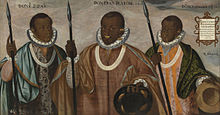The Mulattos of Esmeraldas

The Mulattos of Esmeraldas, also known as The Black Kings of Esmeraldas, is an oil on canvas work painted in 1599 by the mestizo painter es:Andrés Sánchez Gallque, who belonged to the Quito School.[1] It is the oldest signed and dated painting from colonial South America.[2] It is currently part of the collection of the Prado Museum in Madrid although it is deposited in the Museo de América.[3]
The work was commissioned by Juan del Barrio de Sepúlveda, judge of the Real Audiencia of Quito, to send to King Philip III of Spain, as proof of the conversion of the so-called Maroons,[4] black slaves who escaped from European ships or were shipwrecked on the coasts of America, who ended up becoming chiefs of indigenous villages and lived as free people.[5]
Technique[edit]
The canvas is composed in the Mannerist style, which reached the Andes around the year 1580 thanks to the arrival of several Italian painters, and executed in the oil on a canvas 92 cm high by 175 cm wide.[6] The work is unique within the early American colonial context, not only for its quality, but also for the unusual secular theme at that time dominated by religious imagery, and especially for all the associated documentation that exists about the people portrayed and the situation of the African communities settled on the Pacific coast.[7]
Description of the work[edit]
The painting represents es:Francisco de Arobe and his sons Pedro and Domingo, 56, 22 and 18 years old respectively, who were chiefs of the current Ecuadorian region of Esmeraldas.[1] The three subjects, who usually wore blankets and short-sleeved shirts like the Indians of the region, were portrayed in European dress with a Spanish doublet and cape, as well as gold ornaments used by the Andean indigenous peoples, such as necklaces, nose rings, ear decorations and lip piercings.[2]
It is considered that the painting uses Western pictorial language to convey to the King of Spain the submission of a part of the Maroon population to the Crown. The hats held in the hands of two of the subjects signal submission and respect, since they are not placed on the head, and at the same time, as their insides are turned towards the viewer, they indicate no concealment of intentions.[6]
The canvas is signed, an unusual feature in a painting of this period in the viceregal environment. The majority of works are anonymous, and as far as we know the work’s mestizo painter never signed any other of his paintings. Apparently, the fact that it was a commission for the king of Spain was a unique opportunity to assert himself.[7]
References[edit]
- ^ a b Lugo-Ortiz, Agnes; Rosenthal, Angela (2013). Slave Portraiture in the Atlantic World. Cambridge: Cambridge University Press. pp. 120–129. ISBN 9781107004399. Retrieved 15 March 2024.
- ^ a b Mills, Kenneth; Lauderdale Graham, Sandra; Taylor, William (2002). Colonial Latin America A Documentary History. Rowman & Littlefield Publishers. p. 159. ISBN 9780742574076. Retrieved 15 March 2024.
- ^ Dawkins, Farida. "The fascinating story behind the 1599 Mulattos de Esmeraldas painting of African men from Ecuador". face2faceafrica.com. Face 2 Face Africa. Retrieved 15 March 2024.
- ^ Leibsohn, Dana; Mundy, Barbara E. "The Mulatto Gentleman of Esmeraldas". fordham.edu. Fordham University. Retrieved 15 March 2024.
- ^ Frassani, Alessia (2021). Visual Culture and Indigenous Agency in the Early Americas. London: Brill. p. 156. ISBN 9789004468108. Retrieved 15 March 2024.
- ^ a b Gutiérrez Usillos, Andres. "Don Francisco de Arobe y sus hijos, caciques de Esmeraldas". museodelprado.es. Muses del Prado. Retrieved 15 March 2024.
- ^ a b Gutiérrez Usillos, Andrés (2012). "Nuevas aportaciones en torno al lienzo titulado Los mulatos de Esmeraldas. Estudio técnico, radiográfico e histórico". Anales del Museo de América (20). Madrid: 7–64. Retrieved 15 March 2024.
